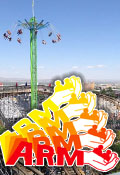L.A. tourist destination adds ADA-compliant path, carousel chariot
AT: Dean Lamanna
SANTA MONICA, Calif. — As cherished elements of the seaside experience, boardwalks and amusement piers lead visitors to spectacular views and lasting memories.
These wooden promenades can also present challenges to those who use wheelchairs, scooters, and even canes and walkers. The planks sometimes form a rough, uneven surface, and the gaps between them can snag wheels and mobility aids.
Last winter, the Santa Monica Pier took a series of steps to enhance accessibility for the millions of visitors it welcomes annually. The upgrades, which comply with the American Disabilities Act (ADA), include a wheelchair-friendly deck path, a new chariot on the pier’s historic carousel, and new entrance ramps at Heal the Bay Aquarium and the Mexican restaurant Mariasol.
“The Santa Monica Pier is an open and welcome platform for everyone,” said Elana Buegoff, pier administrator with the City of Santa Monica’s Economic Development Division, during an early-June visit Amusement Today paid to the 110-year-old local landmark. “We just want to make sure that we’re able to have people of all abilities come and enjoy the pier and the carousel.”
The most impactful addition is the ADA-compliant path spanning the pier’s 1,080-foot length, completed in early February. Starting at the pier’s easternmost entrance, near Ocean Front Walk, the five-foot-wide route runs to an ADA-accessible fishing area at the western end of the pier.
The 50-foot-long flexible mats that form the contiguous path are a product called AccessMat, supplied by AccessRec, LLC, of Clifton, N.J. They are made from non-woven polyester filament — a mesh-like, durable, UV-resistant material that drains water off rapidly and is easy to maintain and replace. The project called for some 15,500 square feet of AccessMat to be secured to the pier’s deck with screws.
“The idea was to make sure we have a smooth surface that covers the gaps in the deck boards,” Buegoff said. “It may or may not be permanent, but it’s a solution.”
Offshoots from the main east-west path connect to other ADA-accessible facilities as well as the two-acre Pacific Park and the 1922 Philadelphia Toboggan Co.-built carousel — a National Historic Landmark that has been housed in the iconic Looff Hippodrome at the front of the pier since 1947.
The carousel, operated for the city since 2001 by Roth Management, saw one of its two chariots replaced with an ADA-compliant one that incorporates the ornate design and color scheme of the original. (The chariot removed from the ride has been stored for preservation and possible future display.) The new chariot features a latched, fold-up bench allowing for wheelchair access / parking, plus seating for a companion. A portable ramp kept in a closet adjacent to the ride can be rolled out quickly by two attendants and positioned for wheelchair access to the carousel platform.
“It’s hard to tell the original chariot and the new chariot apart,” Buegoff said. “We want to convey to other carousel operators that you can be ADA accessible without compromising the machine’s beauty and history.”
Meanwhile, Pacific Park, located just west of the carousel and operated separately by Premier Parks, LLC, is doing its part with ADA-accessible restrooms and other facilities. Although none of its rides are configured to allow wheelchairs within the ride system, all attractions are available to all guests — including those with impaired mobility, as long as they are assisted on and off the ride by someone in their party. Some of the park’s attractions have auxiliary entrances for the convenience of disabled guests. (Complete information at pacpark.com.)
The pier itself and surrounding city beach have other ADA-related and general safety features. Buegoff pointed out a gangway at the far west end of the pier, located discreetly behind some restrooms, that is equipped with a sock-like, seven-meter-long fabric emergency escape chute that unfurls down to a rescue boat. And recently, two ADA-compliant electric beach wheelchairs joined a small fleet of manual ones to offer improved access to the sand.
“I’m on a really committed city team,” said Buegoff, who helped coordinate the ADA upgrades. “Our engineering and maintenance staff, my office of pier management, our landmarks commissioner and attorney’s office — we all work together to make sure the pier is as accessible as possible.”
This article appears in the JULY 2019 issue of Amusement Today.
Get all the industry news delivered to your door!
SUBSCRIBE TO AMUSEMENT TODAY
or download our FREE app to view on your mobile device!



















